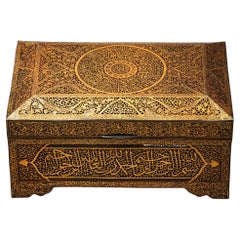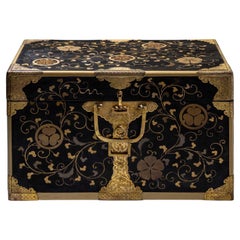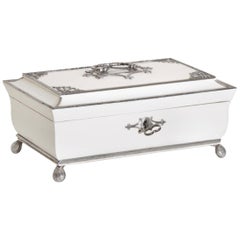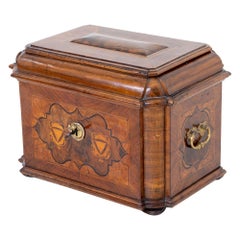Video Loading
Want more images or videos?
Request additional images or videos from the seller
1 of 17
Casket, Indian Colonial Work
$14,869.24List Price
About the Item
- Dimensions:Height: 11 in (27.94 cm)Width: 24 in (60.96 cm)Depth: 18 in (45.72 cm)
- Materials and Techniques:
- Period:
- Date of Manufacture:"Unknown"
- Condition:Refinished. Wear consistent with age and use.
- Seller Location:Greding, DE
- Reference Number:Seller: 078-06811stDibs: LU1014234030342
About the Seller
4.9
Gold Seller
Premium sellers maintaining a 4.3+ rating and 24-hour response times
Established in 1987
1stDibs seller since 2013
516 sales on 1stDibs
Typical response time: 9 hours
Authenticity Guarantee
In the unlikely event there’s an issue with an item’s authenticity, contact us within 1 year for a full refund. DetailsMoney-Back Guarantee
If your item is not as described, is damaged in transit, or does not arrive, contact us within 7 days for a full refund. Details24-Hour Cancellation
You have a 24-hour grace period in which to reconsider your purchase, with no questions asked.Vetted Professional Sellers
Our world-class sellers must adhere to strict standards for service and quality, maintaining the integrity of our listings.Price-Match Guarantee
If you find that a seller listed the same item for a lower price elsewhere, we’ll match it.Trusted Global Delivery
Our best-in-class carrier network provides specialized shipping options worldwide, including custom delivery.You May Also Like
Regency Leather Jewelry, Work and Writing Casket
Located in London, by appointment only
A Regency leather jewelry, work and writing casket,
the hinged lid enclosing a partitioned compartment, the moulded doors enclosing four drawers with faux book spine fronts, the low...
Category
Antique Early 19th Century English Regency Jewelry Boxes
Materials
Leather
An Indo-Portuguese colonial tortoiseshell veneered wooden casket
Located in Amsterdam, NL
India, probably made in Gujarat for Portuguese Goa, late 17th/early 18th century
The tortoiseshell laid over gold foil, and the interior with red lacquer and possibly later added re...
Category
Antique Late 17th Century Indian Jewelry Boxes
Materials
Silver
$16,597
Free Shipping
H 5.52 in W 7.72 in D 4.14 in
Anglo-Indian Art Deco Silver Presentation Casket
Located in London, GB
This Anglo-Indian silver casket is inscribed on a central panel to the front with the following: 'Presented to / Mr. A. L. Guildford, B.Sc. M.I.E....
Category
Early 20th Century Indian Art Deco Decorative Boxes
Materials
Silver
Anglo Indian Inlaid Work Box
Located in Tampa, FL
An anglo Indian workbox made of ebony. The tray lifts up from the box on the lid which is also inlaid in ivory and ebony and has a bone round disc that is signed New Bedford 1810. Th...
Category
Antique 1810s Indian Decorative Boxes
Materials
Bone, Ivory, Ebony
Fine Dutch Colonial Indonesian Casket with Silver Mounts, circa 1706
Located in Amsterdam, NL
A fine Indonesian Ambonya burl, ebony and teak casket with silver mounts
Jakarta (Batavia), circa 1706 (year letter W (1705-1710), marked DV, probably Dirck Vooght
The outer ri...
Category
Antique Early 18th Century Indonesian Dutch Colonial Decorative Boxes
Materials
Sterling Silver
$10,705
Free Shipping
H 5.99 in W 9.85 in D 6.07 in
16th-Century Indo-Portuguese Colonial Mother-of-pearl Gujarat Casket
Located in Amsterdam, NL
An exceptional Indo-Portuguese colonial mother-of-pearl veneered casket with silver mounts
India, Gujarat, 2nd half of the 16th century, the silver mounts Goa or probably Lisbon
Measures: H. 16 x W. 24.6 x D. 16.1 cm
An exceptional Gujarati casket with a rectangular box and truncated pyramidal lid (with slopes on each side and a flat top) made from exotic wood, probably teak (Tectona grandis), covered with a mother-of-pearl mosaic. The tesserae, cut from the shell of the green turban sea snail (Turbo marmoratus, a marine gastropod) in the shape of fish scales, are pinned to the wooden structure with silver ball-headed nails. The casket is set on bracket feet on the corners. The masterfully engraved decoration of the silver mounts follows the most refined and erudite Mannerist repertoire of rinceaux and ferroneries dating from the mid-16th century. The high quality and refinement of the silver mounts and, likewise, the silver nails that replaced the original brass pins used to hold the mother-of-pearl tesserae in place indicate the work of a silversmith probably working in Lisbon in the second half of the 16th century.
The Indian origin of this production, namely from Cambay (Khambhat) and Surat in the present state of Gujarat in north India, is, as for the last three decades, consensual and fully demonstrated, not only by documentary and literary evidence - such as descriptions, travelogues and contemporary archival documentation - but also by the survival in situ of 16th-century wooden structures covered in mother-of-pearl tesserae. A fine example is a canopy decorating the tomb (dargah) of the Sufi saint, Sheik Salim Chisti (1478-1572) in Fatehpur Sikri in Agra district in the state of Uttar Pradesh, north India. This is an artistic production, geometric in character and Islamic in nature, where usually the mother-of-pearl tesserae form complex designs of fish scales or, similar to the dishes also made using the same technique, with the thin brass sheets and pins, stylized lotus flowers. The truncated pyramidal shape corresponds, like their contemporary tortoiseshell counterparts also made in Gujarat, to a piece of furniture used in the Indian subcontinent within the Islamic world prior to the arrival of the first Portuguese. This shape, in fact, is very old and peculiar to East-Asian caskets, chests or boxes used to contain and protect Buddhist texts, the sutras.
A similar chest is the famous and large reliquary chest from Lisbon cathedral that once contained the relics of the city's patron saint, Saint Vincent. Both match in shape, having the same kind of socle or pedestal and bracket feet, and in their engraved silver mountings, featuring the same type of refined, erudite decoration. Their differences lie in the silver borders that frame the entire length of the edges of the chest (both the box and the lid), pinned with silver nails, and on the lock plate, shaped like a coat of arms in the Lisbon example. Given the exceptional dimensions of the reliquary casket...
Category
Antique 16th Century Indian Jewelry Boxes
Materials
Silver
$273,593
Free Shipping
H 6.3 in W 9.69 in D 6.34 in
Large Antique South Asian Colonial Carved Camphor Wood Table Box Jewelry Casket
Located in Forney, TX
A scarce antique circa 1900 South Asian hand carved wooden decorative table box / jewel casket.
Hand-crafted in the early 20th century, likely British Ceylon (present day Sri Lanka)...
Category
Early 20th Century South Asian Jewelry Boxes
Materials
Wood
$2,500
H 15.75 in W 17 in D 13 in
Anglo Indian Colonial Brass Inlaid Teak Jewelry Box
Located in Moreno Valley, CA
A Beautiful Anglo Indian, Colonial, brass inlaid teak jewelry lidded box made for the English market.
handcrafted with floral and hearts brass inlays on top are surrounded by brass inlaid border, intricate brass inlays design of florals and scrolls carries through to all four sides so will display nicely on a shelf, desk or coffee table.
Displays a desirable aged patina and the teak wood shows fine grain interest and deep caramel hues.
A large Anglo-Indian teak colonial Campaign casket with brass inlay, the hinged cover opens to reveal an original fitted interior with two compartments interior lined with red velvet.
This is a distinctive and highly appealing vintage semi antique Anglo Indian jewelry...
Category
Mid-20th Century Indian Anglo-Indian Decorative Boxes
Materials
Brass
18th-century Dutch-colonial Peranakan mother-of-pearl casket with silver mounts
Located in Amsterdam, NL
An Indonesian Peranakan mother-of-pearl inlaid mastic sirih casket with silver mounts
Jakarta (Batavia), circa 1720-1730, the silver hinges marked for Batavia, maker’s mark HS or SH...
Category
Antique Mid-18th Century Indonesian Dutch Colonial Antiquities
Materials
Silver
$33,307
Free Shipping
H 3.94 in W 10.24 in D 6.89 in
Fine Indian Silver Filigree Casket with Hinged Cover, 18th Century
Located in Amsterdam, NL
A pair of very fine silver filigree rosewater sprinklers
Possibly India, Karimnagar, early 18th century
Measures: Height 31.6 cm and 31.7 cm,...
Category
Antique 18th Century Indian Metalwork
Materials
Silver
$11,300
Free Shipping
H 3.75 in W 5.91 in D 4.1 in
More From This Seller
View AllIndo-Persian Iron Casket in Koftgari Technique, 2nd Half 19th Century
Located in Greding, DE
Exceptional Indo-Persian iron casket intricately decorated using the Koftgari technique—fine gold wires hammered into the iron surface. Adorned with delica...
Category
Antique Late 19th Century Asian Decorative Boxes
Materials
Gold, Iron
Japanese Lacquer Chest, Edo Period
Located in Greding, DE
Small rectangular Japanese chest with gold lacquer decoration in the form of leaf tendrils. The chest is decorated with cut-out and ornamentally engraved fittings on the corners and ...
Category
Antique 18th Century Japanese Edo Decorative Boxes
Materials
Brass
Small Jewelry Box, Probably, Vienna, 19th Century
Located in Greding, DE
White lidded box standing on small spherical feet with trapezoidal body and lid with a groove. The fittings are silver plated. Key available. Interior veneered in cherry.
Category
Antique 19th Century Austrian Biedermeier Jewelry Boxes
Materials
Wood
$2,379 Sale Price
20% Off
Baroque Guild Chest, Mid-18th Century
Located in Greding, DE
Baroque guild drawer with side brass handles and domed lid. The body stands on pressed ball feet, has rounded corners and is veneered on all sides in walnut with strapwork marquetry.
Category
Antique Mid-18th Century Baroque Decorative Boxes
Materials
Brass
Egg-Shaped Wooden Box by Maison Alphonse Giroux, Paris, 2nd Half of the 19th C.
By Alphonse Giroux et Cie
Located in Greding, DE
An exquisite egg-shaped wooden box by Maison Alphonse Giroux, crafted in the second half of the 19th century. The box rests on a round base and features metal fittings, including a d...
Category
Antique Late 19th Century French Decorative Boxes
Materials
Metal
Tea Chest, Germany First Half of the 19th Century
Located in Greding, DE
Lidded chest with a curved lid and a concave belly, standing on brass ball feet. The escutcheon is inlayed in bone. Mahogany veneered.
Category
Antique Early 19th Century German Biedermeier Tea Caddies
Materials
Brass
$1,712 Sale Price
20% Off
Recently Viewed
View AllMore Ways To Browse
Indian Silver Casket
Sandalwood Chest
Red Dispatch Box
Rifle Box
Sevres Candy
Tiffany Bunny
Vintage Cat Trinket Box
Vintage Pistol Case
Art Deco Makeup Mirror
Borghese Box
Decorative Faux Shagreen Box
Salt Box Hanging
Thorens Music Box
Wicker Elephant Box
Antique Boot Box
Antique Pewter Trinket Boxes
Collapsible Top Hat
Gio Hermes



